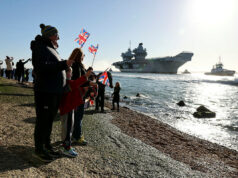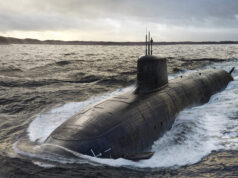RFA Cardigan Bay has returned to the UK after a two-year deployment in the Middle East and Mediterranean, where it played a crucial role in supporting humanitarian aid efforts in Gaza, according to a press release.
The Royal Fleet Auxiliary (RFA) amphibious support ship had been initially tasked with protecting key shipping lanes alongside Royal Navy minehunters.
However, in April 2024, the ship was re-tasked to assist in delivering essential supplies to Gaza amidst the ongoing Israel-Hamas conflict.
Captain Mark Colley, Commanding Officer of RFA Cardigan Bay, commended his crew for their resilience and dedication during this mission. “The can-do attitude of the ship’s company never ceases to amaze me, even when faced with the prospect of drone and missile attacks in the Bab Al Mendeb Straits. Everyone demonstrated professionalism and resolve knowing that we were making a difference,” Colley said.
The humanitarian mission involved the transfer of nearly 11,000 tonnes of aid, including medical, nutritional, and water supplies, to Gaza. A key part of this effort was the construction of a U.S.-led temporary floating pier, designed to expedite the delivery of humanitarian cargo.
The pier, operational between May and July 2024, played a critical role in creating a maritime aid corridor to Gaza, with assistance from various international forces, including RFA Cardigan Bay.
RFA Cardigan Bay has now been replaced by its sister ship, RFA Mounts Bay, which will continue contingency operations in the Eastern Mediterranean. The return of Cardigan Bay was marked by a formal welcome at Portland, attended by Rear Admiral Jude Terry, the Royal Navy’s Director People and Training, and Commodore Sam Shattock, the newly appointed RFA Head of Service.
The floating pier, which connected offshore U.S. ships to Gaza, allowed for the efficient transfer of humanitarian aid, delivering 150 trucks of aid per day at its peak. Although the pier was dismantled several times due to rough sea conditions, it managed to deliver 8,800 tonnes of aid before its closure in July 2024.














Correction: after supporting Hamas
Sending aid to civilians in Gaza is not supporting Hamas. It’s crucial to stop unnecessary and avoidable deaths of civilians.
Dumb response.
Defense News puts the figure at “more than 20 million tons of aid” from the pier. Given the Gaza Strip population is around 2m, each received over 10 tons of aid over the last four months from the US alone. Given that a UK citizen eats maybe 200kg of food in 4 months, I wonder what aid Defense News thinks the US are providing: half a ton of bedding, two tractors for every family and a free set of barbells for the under 2s, perhaps.
ROFLMAO. Maybe people are just making the stats up as they go along. Maybe they meant 20 thousand tons. None of it adds up.
Best guess was around 300k tonnes of aid went in. Most of it remained sat ashore and couldn’t be moved out because of issues with Hamas stopping the trucks and nicking it.
Cost north of 300Mil dollars just for the pier. Lesson Learned is dont do it again. Wase of time and effort and there are better options. The USN and Army are revisiting the pier concept. ThinkDefence has some really good stuff on bringing aid into remote locations and the systems that are available to do it. Worth a read.
I was supposed to be starting her drydocking and underwater hull inspection here around now…that was binned when they sent her to the Med and it will have to happen in the UK.
Lloyds and UKMCA inspections in dry dock are mandatory now at a shorter time interval because of hull age. Nothing wrong with the hull by the way…she is in a very very good condition but them’s the rules!
Very good crew on there. I did do a lot of work on here over the past years in alongside maint periods and fixing emerging defects. It would have been nice to get a drydocking in as well but hey ho.
Enjoy the time back in the UK Peeps and hopefully see you or a sistership back out here next year.
Congratulations and very well done to RFA Cardigan, and all those who sailed with her over the past few years.
So what’s next on the agenda for Cardigan Bay? Drydocking, testing, refitting and then tied up to an Albion Class for a couple of years?